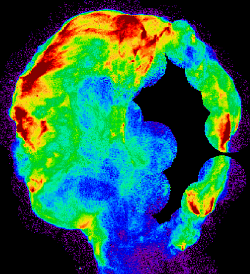Einstein’s “Mistake” is Revived

Astronomers now say that the Universe is not only expanding, but the expansion is accelerating with time. The most popular explanation is an exotic “dark energy” that on a cosmic scale overcomes the tendency to decelerate. In the 26 July PRL a team of cosmologists tries to discriminate among various models for this mysterious energy by combining several types of astronomical data. They found that a cosmological constant–a simple idea which Einstein famously abandoned–is the favored explanation, while some other proposals are ruled out.
Until the past few years, one of the central questions in cosmology was the fate of the Universe: Will it expand forever, coast asymptotically to a standstill, or eventually collapse in upon itself in a “big crunch”? These options were always associated respectively with so-called open (low mass), flat (“critical” mass), or closed (high mass) models of the Universe, but now that dark energy appears to exist, the possibilities are more complicated. We could have a closed Universe that continues to expand, pushed on by the mysterious repulsive energy, explains Saul Perlmutter, of the Lawrence Berkeley National Laboratory in California.
The dark energy is not a repulsion between particles of matter. It’s an energy that causes space itself to expand, and it may be related to the sea of short-lived virtual particles that according to quantum mechanics fills all of space. The most important characteristic of the dark energy is w, the ratio of the pressure it imposes divided by the dark energy density. w = -1 corresponds to the simplest model for dark energy, the cosmological constant, an isotropic repulsive term Einstein added to the equations for his theory of gravity for consistency with the static Universe assumed at the time. He later took the constant out, but it has reappeared several times since then as cosmologists have attempted to explain one strange observation or another.
To constrain the value of w and thus discriminate among dark energy models, Perlmutter and his colleagues used recent data of three types: measurements of the small variations in the cosmic microwave background; the density of galaxies over large distances; and the expansion speed versus distance relations gained from observing distant supernovae. They found that the combination leads to constraints that are much stronger than any data set alone, favoring Einstein’s simple cosmological constant ( w = -1), but allowing for a w as large as -0.6. Other dark energy models the team found disfavored by the data included ones invoking topological defects–microscopic barriers in spacetime–and models where the outward pressure changes as the Universe ages.
Perlmutter stresses that the research is still in “an early stage”–he expects to discriminate more convincingly among models in the coming years, as the many long-term observing projects currently underway report more data. Joel Primack, of the University of California at Santa Cruz, says that it’s important to constrain w now that dark energy seems to be a reality, and none of the models stand out. “People had hoped that there would be some theory that would be obviously more beautiful than alternatives,” he says. But Primack is not surprised by the results, since other types of analyses have recently reached similar conclusions. The next problem is to explain the origin of the mysterious energy. Although Primack and others have in the past worked out detailed theories that included a cosmological constant, “I always resisted the idea,” he says, “because it’s very hard to understand where it comes from physically.”


